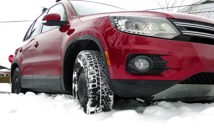 The NHL regular season is upon us, the Winnipeg Blue Bombers have almost surely put themselves out of contention for the CFL playoffs (never mind that the Grey Cup final is in Winnipeg this year), and here in the Prairies we’re starting to see frost on our cars first thing in the morning. What could all that mean? Time for winter tires, of course!
The NHL regular season is upon us, the Winnipeg Blue Bombers have almost surely put themselves out of contention for the CFL playoffs (never mind that the Grey Cup final is in Winnipeg this year), and here in the Prairies we’re starting to see frost on our cars first thing in the morning. What could all that mean? Time for winter tires, of course!
A quick scan of temperatures across our vast country reveals that most centres are still well above freezing, even overnight, and there’s nothing in the way of snow cover for these areas. Still, there are benefits of changing over to winter tires a little earlier in the season than necessary.

Let’s start with a bit of a refresher. Winter tires sold in Canada bear the snowflake-on-mountain symbol, which is a stamp of approval from Transport Canada that the tires are suitable for winter use. Specifically, they all pass a standard test from the ASTM (American Standard for Testing and Materials) for traction on medium-packed snow.
There are three primary characteristics shared by winter tires: first, a softer, more flexible rubber compound is used to keep the tires from turning to bowling balls in cold temperatures; second, an aggressive tread pattern with wide grooves between tread blocks helps the tires dig down and evacuate the snow and slush that can prevent proper contact with the road surface; finally, narrow zigzag slots, or sipes, in the tread blocks allow more tread flex and a higher number of small edges with which the tires can grip a slick surface.
These characteristics together make for improved performance in all cold-weather situations, not just those that involve snow and ice.
According to the Rubber Association of Canada (and as generally accepted by the industry as a whole), winter tire compounds start to show their traction advantage over summer and all-season tires when the mercury dips below a balmy seven degrees Celsius. In most of the country, folks, we’re either already there or will be very soon.
There’s also a more practical reason to get those winter tires installed early. Sure as you shouldn’t eat yellow snow, tire stores will be packed with customers when the first flake of the white stuff descends from the sky. A typical early-winter scene at a tire store is a showroom filled with stacks of customer tires and a lineup out into the parking lot for those anxious to keep their daily commute safe. It’s even more chaotic if the first snowfall is significant. Why not avoid the rush and get it done now, when only the most proactive of drivers enjoy the low-stress experience of a more relaxed tire installation process?
Now, there is such a thing as switching over to winter rubber too early, for the same reasons that you shouldn’t be driving on your dedicated winter tires through the summer. If the temperature is still above seven degrees during the hours you’ll be driving, then it’s not quite time yet. Winter tires wear faster than all-seasons at warmer temperatures, and handling characteristics of winter tires suffer if it’s not cold enough. Be smart about when to make the switch, and you’ll be maximizing safety while saving money by extending the life of your tires.
The bottom line is that temperature, not the presence (or absence) of the white stuff, should be your guide in determining when to install your winter tires.


